ॐ पितृभ्यो नमः।
श्रद्धया पितॄन् स्मरामि विश्वपितॄन् च सर्वशः।
तेषां पुण्यकृतां देवानां च पितॄणां च वयं नमामः।
i.e.,
Om salutations to the ancestors.
With reverence, I remember the ancestors, the universal forefathers who are virtuous gods.
To them, the holy ones and the ancestors, we offer our salutations.
Hello friends!
Welcome to our channel. The auspicious occasion of Mahalaya Amavasya is here with us once again. According to the Hindu calendar, Mahalaya Amavasya day is considered the last and most important day of Pitru Paksha, also known as Sarva Pitru Amavasya. On this day, we pay homage to our ancestors through rituals like Shradh, Tarpana, and Pitra Karma, and pray for the peace of their souls.
It is believed that during the 16 days of Pitru Paksha, our ancestors visit the earth, and on Mahalaya Amavasya, they return to their celestial abode. It is also believed that this day marks the arrival of Goddess Durga on earth, signifying the beginning of Sharad Navratri. This festival emphasizes the importance of devotion, service, and charity in honoring our ancestors and welcoming the Goddess. So, let’s begin!
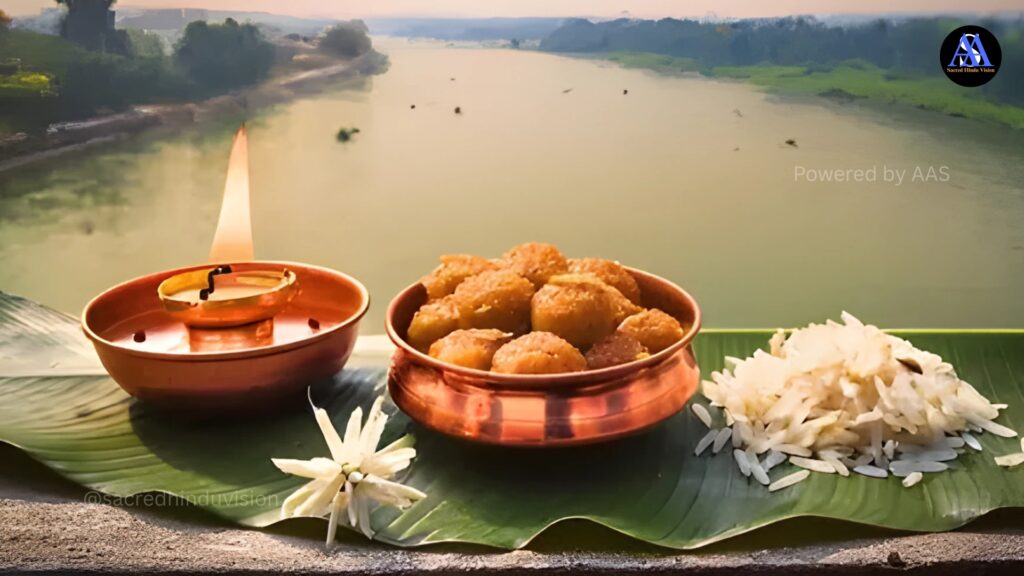
What is Mahalaya Amavasya? (महालय अमावस्या क्या है?)
- Mahalaya Amavasya is an important day in Hinduism, falling at the end of Pitru Paksha. It is observed on the new moon day of the Hindu month of Ashvin. On this day, people pay homage to their ancestors, offering them rituals like Tarpan and Pind Daan to appease their souls. Mahalaya Amavasya Day is dedicate to offering peace and liberation to the souls of the departed, where people offer water, food, and other offerings in their memory. In Bengali culture, it marks the beginning of Durga Puja, when Goddess Durga is invited.

Why Mahalaya Amavasya observed?
- Mahalaya Amavasya is an important day in Hinduism, falling at the end of Pitru Paksha. It is observed on the new moon day of the Hindu month of Ashvin. On this day, people pay homage to their ancestors, offering them rituals like Tarpan and Pind Daan to appease their souls. This day is dedicated to offering peace and liberation to the souls of the departed, where people offer water, food, and other offerings in their memory. In Bengali culture, Mahalaya Amavasya marks the beginning of Durga Puja, when Goddess Durga is invited.
History Behind Mahalaya Amavasya (महालय अमावस्या – इतिहास) :
- The tradition of Mahalaya Amavasya is rooted in ancient Hindu texts and Puranas. A famous story from the Mahabharata recounts how Karna did not receive food in heaven because he had not offered alms to his ancestors during his lifetime. Therefore, he was granted permission to return to earth for 15 days, known as Pitru Paksha, with the Amavasya day marking its culmination. In Bengali tradition, this day is associated with the arrival of Goddess Durga.
- Since the 1930s, All India Radio has broadcast ‘Mahishasuramardini’ on the morning of Mahalaya, signaling the start of Durga Puja. Historically, this day evolved from the practice of ancestor worship, which dates back to the Vedic period, where ancestors were revered as deities.
Impact of Mahalaya Amavasya on People (इसका लोगों पर क्या प्रभाव पड़ता है):
- Mahalaya Amavasya has a profound spiritual, cultural, and emotional impact on people. Spiritually, it is a way to seek blessings from ancestors, which brings prosperity, health, and protection in life. People believe that appeasing the ancestors resolves family problems and frees descendants from their sins.
- Culturally, especially in Bengal, Mahalaya Amavasya marks the vibrant beginning of Durga Puja, uniting the community and preserving traditions. People wake up early to listen to the Mahalaya broadcast on radio or TV, evoking nostalgia and a festive spirit. Emotionally, it is a day of remembrance and mourning, where people remember their departed loved ones, providing solace. Overall, this day connects people to their roots, instills gratitude, and reminds them of the cycle of life, fostering harmony and spirituality in society.
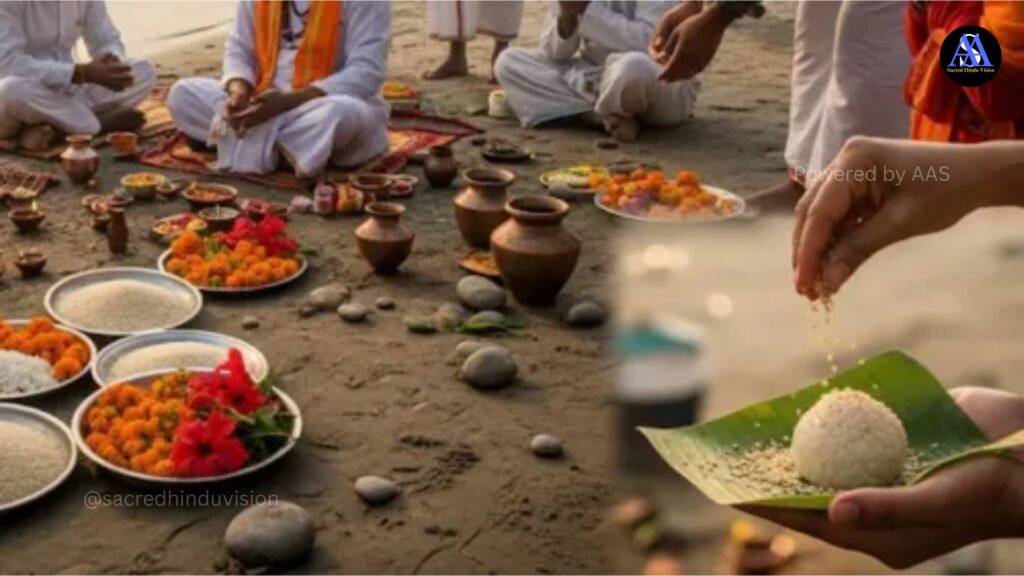
How is Mahalaya Amavasya celebrated in different states?
Mahalaya Amavasya (or Sarva Pitru Amavasya) is celebrated by the Hindu community across India, but the rituals and festivities vary regionally. It primarily marks the culmination of Pitru Paksha, during which offerings of water, food, and prayers are offered to the ancestors. Details according to major states/regions are given below:
West Bengal (पश्चिम बंगाल):
- Here, Mahalaya Amavasya symbolizes the beginning of Durga Puja. People wake up early to recite the ‘Devi Mahatmya’ (Chandi Path) and listen to the ‘Mahishasuramardini’ program broadcast on All India Radio, narrating the story of Goddess Durga’s victory over Mahishasura. Offerings of food, water, and prayers are made to the ancestors at home or in community prayer halls. This day initiates the preparations for Durga Puja, with rituals for inviting Goddess Durga beginning. It is a vibrant and spiritually significant festival in Bengali culture.
Bihar (बिहार), especially Gaya (विशेष रूप से गया):
- Gaya is a major pilgrimage site for Pitru Paksha, where the ‘Pitru Paksha Mela’ is held. Millions of devotees offer prayers and perform rituals on the banks of the Phalgu River, believing it to be particularly auspicious for the liberation of the souls of departed ancestors.
- The rituals of Shradh, Tarpana, and Brahmin Bhoj are prominent. Mahalaya Amavasya day is dedicated to all ancestors, and the rituals here are renowned throughout India.
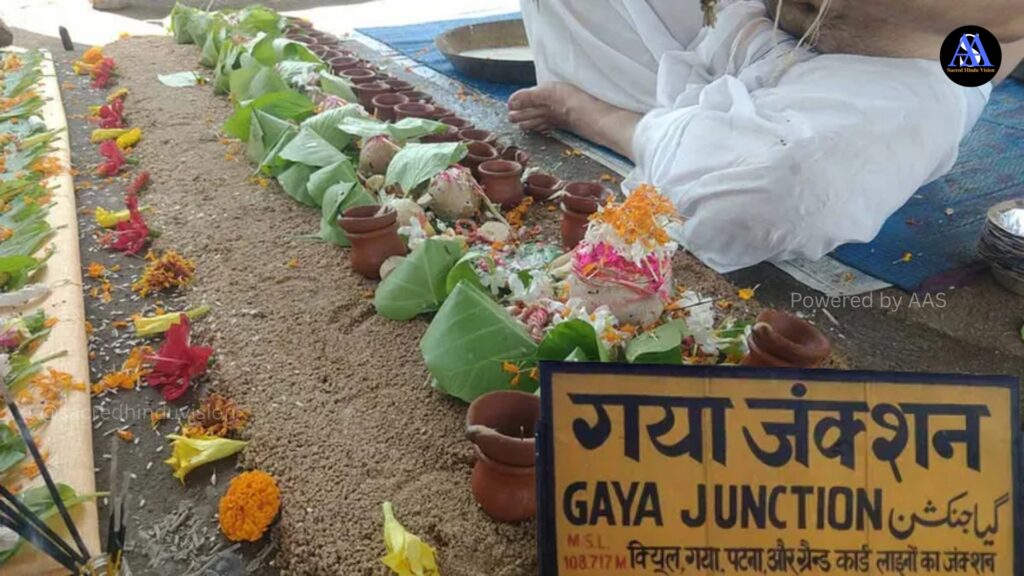
North India (उत्तर भारत), such as Uttar Pradesh (Varanasi, Prayagraj), Haridwar:
- Here, it primarily marks the culmination of the Pitru Paksha rituals. Tarpana, offering of rice balls, and Vishnu-Yama worship are performed on the banks of the Ganges or other sacred rivers. Elaborate rituals are observed in places like Varanasi and Prayagraj.
- People wear traditional attire, including a dhoti and a ring made of sacred grass, and offer rice balls made of rice, barley, ghee, and sesame seeds. Feeding crows is considered a sign of ancestral satisfaction.
South India (दक्षिण भारत), such as Andhra Pradesh, Telangana, Karnataka, Tamil Nadu:
- It is celebrated on the Amavasya (new moon day) of the month of Bhadrapada, according to the Amavasant Panchang. Here, Lalithambika (a form of Goddess Durga) is worshipped, and the story of Mahishasura Mardini is narrated.
- Rituals like Shradh, Tarpana, and offering food are central to Pitru Paksha, performed at home or in temples. It focuses on remembering ancestors and seeking their blessings.
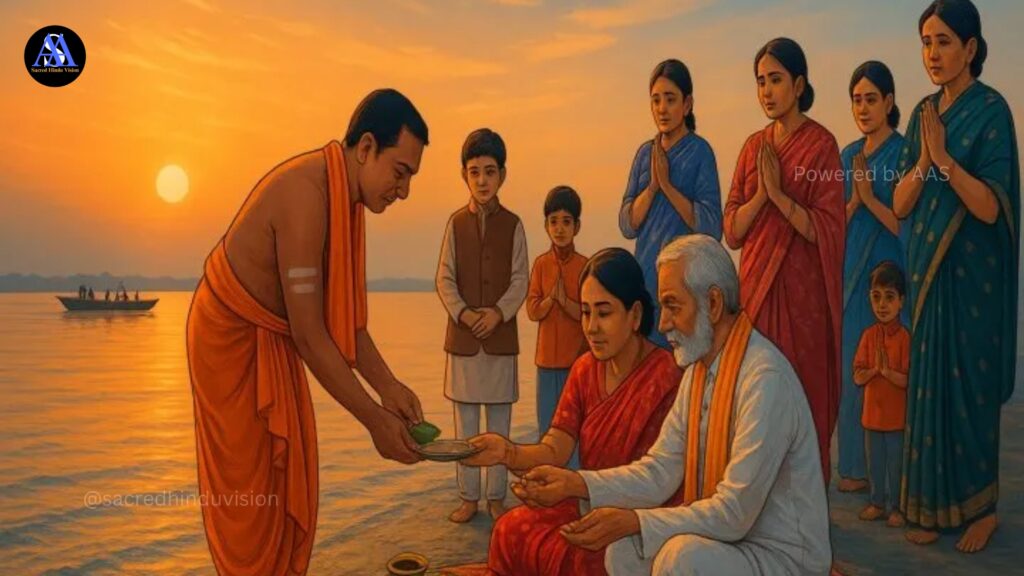
Other States (General in other states like Maharashtra, Odisha):
- In Maharashtra and Odisha, Pitru Paksha rituals are also significant, emphasizing Tarpana and charity. In Odisha, it is linked to Durga Puja. Overall, across India, these days revolve around offering food (like kheer, lapshi, dal) to ancestors and performing acts of charity.
These variations stem from local traditions, the lunar calendar (Purnimant or Amavasya), and cultural influences.
Any Scientific Basis?
- Mahalaya Amavasya is primarily religious and spiritual, but it also has some psychological and symbolic aspects linked to modern science. While rigorous scientific evidence is limited, the following points are noteworthy.
- Astronomical Aspect: Amavasya marks the new moon phase, when the moon and sun are aligned. This affects tides on Earth, which, according to some studies, influence mental health and emotions. In Hindu tradition, this time is considered auspicious for the ‘arrival’ of ancestral spirits, providing a serene atmosphere for reflection due to the low light.
- Psychological Benefits: Remembering and honoring ancestors fosters gratitude, a source of stress reduction and improved mental health in modern psychology. These rituals reinforce family continuity, providing emotional closure and strengthening ancestral bonds. Studies suggest such rituals aid in grief processing, reducing depression and anxiety.
- Yogic/Energetic Perspective: In some yogic traditions (such as Sadhguru’s interpretation), it is viewed as a transmission of ‘cosmic energy,’ where the rituals impart positive energy to the descendants. It symbolizes the balancing of ‘ancestral karma’ (Pitr Dosha), which influences us at both genetic and karmic levels. While primarily spiritual, it also fosters psychological benefits, such as strengthening family bonds. Overall, from a scientific perspective, it exemplifies ‘cultural adaptation,’ reinforcing social cohesion.
- Ultimately, Mahalaya Amavasya day teaches us that strong roots lead to a prosperous present and future.
Conclusion (निष्कर्ष)
- Mahalaya Amavasya symbolizes gratitude to our ancestors, cultural continuity, and spiritual renewal, celebrated with unique local traditions across different states—from the Durga Puja fervor in Bengal to the Pitra Tarpana rituals in Gaya. The psychological benefits it offers, such as emotional peace and strengthened family bonds, make it relevant even in modern life. Ultimately, this day teaches us that strong roots lead to a prosperous present and future.
Mahalaya Amavasya is a sacred Hindu observance marking the end of Pitru Paksha—a period dedicated to honoring ancestors through rituals like shraddha and tarpan. Families across India pay homage to departed souls, seeking their blessings and peace. This day not only upholds the tradition of expressing gratitude to ancestors but also heralds the onset of Devi Paksha and Durga Puja celebrations. Mahalaya Amavasya stands as a beautiful blend of remembrance, spiritual reflection, and the renewal of hope, emphasizing the eternal bond between generations and the cyclical nature of life itself.
मा चक्षुषः श्लाघांमृत्यूनां तयोर्द्विज मातरः।
अश्वापनं तर्पणं वा यज्ञाज्यसूत्रसंश्रितम्।
सा विद्या या विमुक्तये पितृभ्यो यज्ञशीलिनाम्॥
i.e.,
May there be no reproach from the eyes of the departed ancestors,
Whether by offerings or by feeding the sacrificial fire.
That is true knowledge which liberates the ancestors who are devoted to the Yajna (sacrifice).
In today’s blog, we explored how Mahalaya Amavasya is not merely a religious festival, but also conveys a message of emotional and spiritual renewal in our lives. Let us all remember our ancestors with reverence and love on this Mahalaya Amavasya, and draw inspiration and blessings from their teachings to steer our lives towards positivity and prosperity. This is the true essence of this sacred festival.
If you liked this blog, please like, share it, and visit our website. Share your thoughts and suggestions in the comments section.
Thank you.
जय श्री राम।।
Please Share Through Various Platforms.
Sharad Purnima – Revolutionary Rituals & its importance
या देवी सर्वभूतेषु शक्ति-रूपेण संस्थिता।नमस्तस्यै नमस्तस्यै नमस्तस्यै नमो नमः॥ i.e., “Salutations again and again to the Divine Goddess who dwells in all beings in the form of power (Shakti).” Hello friends. Welcome to our Website. This blog is going to be a sensation for everyone thinkers definitely. In this blog, we will talk about The Great Iron Man: – Sardar Vallabhbhai Patel & his thoughts and actions for Hindus & Hindu visions. In the vast
Durga Puja: Mahashaptmi Significance, Rituals, and Spiritual
या देवी सर्वभूतेषु शक्ति-रूपेण संस्थिता।नमस्तस्यै नमस्तस्यै नमस्तस्यै नमो नमः॥ i.e., “Salutations again and again to the Divine Goddess who dwells in all beings in the form of power (Shakti).” Hello friends. Welcome to our Website. As the warm colors of autumn mix with the sweet smell of shiuli flowers and the lively beats of dhak drums, Durga Puja 2025 begins on Mahashashthi, which is September 28. This five-day event is full of deep devotion, beautiful

“Navaratri: A Pivotal Tour of Inner Power and Divine Triumph”
या देवी सर्वभूतेषु शक्ति-रूपेण संस्थिता।नमस्तस्यै नमस्तस्यै नमस्तस्यै नमो नमः॥ i.e., “Salutations again and again to the Divine Goddess who dwells in all beings in the form of power (Shakti).” Hello friends. Welcome to our Website. Today we will discuss a topic i.e., Navratri: A Vibrant Nine-Day Festival of Devotion, Dance, and Divine Power. Navratri, meaning “nine nights” in Sanskrit (“nava” for nine, “ratri” for nights), is one of India’s most colorful and spiritually significant Hindu
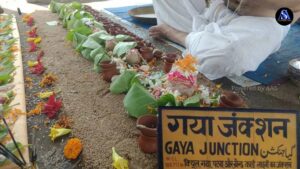
Mahalaya Amavasya: A Sacred and Spiritual Festival – 02
Mahalaya Amavasya is a sacred Hindu observance marking the end of Pitru Paksha—a period dedicated to honoring ancestors through rituals like shraddha and tarpan. Families across India pay homage to departed souls, seeking their blessings and peace. This day not only upholds the tradition of expressing gratitude to ancestors but also heralds the onset of Devi Paksha and Durga Puja celebrations. Mahalaya Amavasya stands as a beautiful blend of remembrance, spiritual reflection, and the renewal of hope, emphasizing the eternal bond between generations and the cyclical nature of life itself.

महालय अमावस्या: एक पावन और आध्यात्मिक पर्व
ॐ पितृभ्यो नमः।श्रद्धया पितॄन् स्मरामि विश्वपितॄन् च सर्वशः।तेषां पुण्यकृतां देवानां च पितॄणां च वयं नमामः। i.e., Om salutations to the ancestors.With reverence, I remember the ancestors, the universal forefathers who are virtuous gods.To them, the holy ones and the ancestors, we offer our salutations. नमस्कार दोस्तों! स्वागत है आपका हमारे चैनल पर। महालय अमावस्या का यह शुभ अवसर हमारे बीच एक बार फिर उपस्थित हुआ है। यह दिन हिन्दू पंचांग के अनुसार पितृ पक्ष का

Hindutva: The Ultimate Political Empowerment of Culture – 02
नमस्ते सदा वत्सले मातृभूमे त्वया हिन्दुभूमे सुखं वर्धितोहम्।महामङ्गले पुण्यभूमे त्वदर्थे पतत्वेष कायो नमस्ते नमस्ते॥ i.e., O loving Motherland, I always salute you! On this Hindu land, I have grown up happily with your nurture and care. O most auspicious and sacred land, for your sake I offer this mortal body. I bow to you again and again.. Hello friends! Welcome to our Website. Today we will discuss a topic that has deeply influenced Indian politics:

Mahalaya Amavasya: A Sacred and Spiritual Festival – 02
Mahalaya Amavasya is a sacred Hindu observance marking the end of Pitru Paksha—a period dedicated to honoring ancestors through rituals like shraddha and tarpan. Families across India pay homage to departed souls, seeking their blessings and peace. This day not only upholds the tradition of expressing gratitude to ancestors but also heralds the onset of Devi Paksha and Durga Puja celebrations. Mahalaya Amavasya stands as a beautiful blend of remembrance, spiritual reflection, and the renewal of hope, emphasizing the eternal bond between generations and the cyclical nature of life itself.




Pingback: Sharad Purnima - Revolutionary Rituals & Its Importance - 01